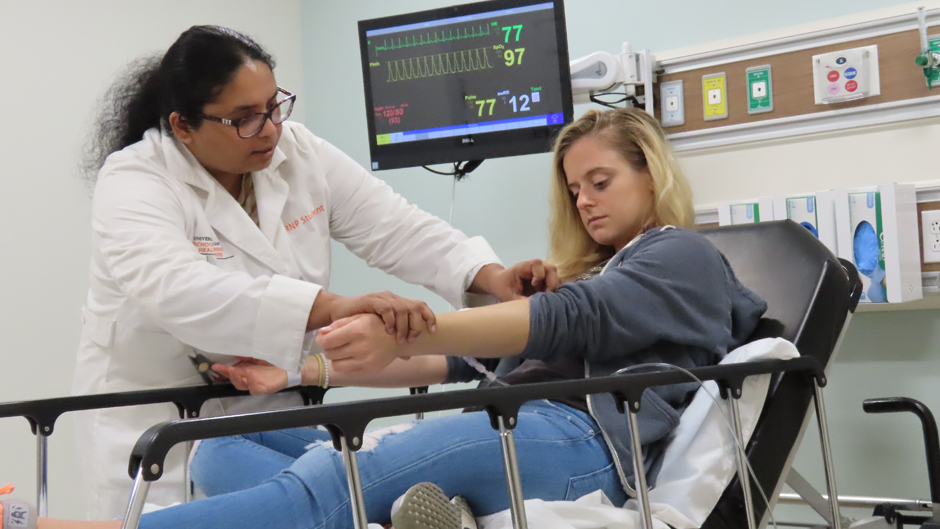Looking back, Jauvana Hall-Wills, M.S.N. ’20, sees that the terrified patient with bruises, who signed herself out against medical orders, must have been a victim of human trafficking. But at the time, she didn’t fully grasp the horror her patient was facing.
Years later, a simulated human trafficking educational experience at the School of Nursing and Health Studies, eerily similar to that encounter, helped Hall-Wills piece the red flags together. In both cases, she could hear an angry voice coming through the patient’s cell phone, ordering the patient to leave the hospital despite a clear need for medical care.
“I was like, ‘We’re trying to take care of you, you’re in a safe place,’ but she was just so scared,” recalls Hall-Wills. “There were many signs there we didn’t connect. Now I’ll know. I’ll be able to handle it better.”
Stories like Hall-Wills’ are not uncommon. “Approximately 68 percent of trafficked survivors report contact with health care providers during their time held captive,” say SONHS faculty Deborah Salani and Beatriz Valdes.
That’s why Salani and Valdes, associate and assistant professors of clinical, respectively, developed a simulation-based intervention for nursing students at SONHS focused on human trafficking awareness. That educational initiative, “Do You See What I See? Recognizing Human Trafficking,” recently won a Cane Crusader Award from the University of Miami Citizens Board.
Through it they are preparing students like Hall-Wills to identify, screen, and assist potential trafficking victims encountered in clinical settings.
“Most health care providers do not recognize the red flags associated with human trafficking,” explains Salani, director of the post-master's certificate program in psychiatric-mental health nursing. “More education is essential.”
Human trafficking (HT)—the enslavement of people for labor, services, and/or commercial sex—is one of the fastest growing criminal enterprises. The International Labor Organization estimates there to be over 40 million victims globally, with hundreds of thousands in the United States. Florida has the nation’s third-highest rate of human trafficking, according to National Human Trafficking Hotline statistics, and Miami-Dade County marks the epicenter of the state’s public health crisis.
“Every nurse needs to have the ability to respond in an appropriate way to someone in trouble,” says Dean Cindy L. Munro, noting that human trafficking awareness training should be as commonplace and available to health providers as basic lifesaving techniques.
The Florida Board of Nursing agrees. Its mandate for continuing education on the topic went into effect in 2019. That same year, Salani and Valdes rolled out their simulation-based program, built around nationally established best practices from organizations like HEAL (Health, Education, Advocacy, Linkage) Trafficking.
Last year SONHS hosted the HEAL Human Trafficking Awareness Summit and a presentation by Miami-Dade State Attorney Katherine Fernandez Rundle, whose Human Trafficking Unit has worked with more than 700 human trafficking victims and filed over 685 human trafficking-related cases since 2012.
In developing their recognition intervention, Salani and Valdes also collaborated with Lindsay Lester, A.B.S.N. ’19, then a student in the accelerated B.S.N. program who already had a master’s in psychology and experience with both trauma-informed care and sexual assault response.
In addition to consulting with Salani and Valdes on a national presentation and the HT simulation scripts, Lester volunteered to serve as the program’s first standardized patient. (Standardized patients in human trafficking scenarios require specialized training and should never be actual survivors so as to avoid retraumatization, experts note.)
“It was well-received,” Lester says of the simulation. “Some of the clinicians picked it up quicker than others, but everyone was able to get the gist of what this simulation was about, and that’s the important thing.”
Lester portrayed two different patients—one a victim of labor trafficking, the other of sex trafficking. Her back-story, medical history, and script were carefully tailored to test students’ awareness levels and improve their responsiveness in assisting potential victims.
“It is important for nurse practitioner students to recognize contextual clues that may be helpful in identifying a HT patient, especially if the patient is withholding information or is a poor historian,” says Valdes.
Clues that a patient may be trapped in the waking nightmare of human trafficking vary widely but can include a lack of ID or personal items, evidence of physical neglect and psychological trauma, hunger, agitation, and branding marks, such as tattoos. For Lester, now a registered nurse in Nevada, the key to connecting is emotional intelligence, “really pushing your own judgment and opinions aside.”
“The patient you’re helping, their safety is the most important,” Lester continues. “They’ve been stripped of their human rights and pretty much any decision they’re making about their body, so giving them their control back—even if it’s in a 20-minute session—that’s a start. You can’t just expect someone to come right out and say, ‘This is my story and I need help.’ It takes time.”
Learning through simulation brought that message home for nurse Jauvana Hall-Wills. “As nurses, often we’re rushing and we’re standing over the patients, so I had to step back from that role, especially in a situation like this, where I think it might be human trafficking,” she says. “It’s not just about checking things off my list or giving medication… I have to have the patient feel comfortable enough to open up to me—give her food, water, a blanket, before going in and asking questions.”
Her advice to other health care providers? “Even if the hotline number is all you know, just that number could help one person.”
To report suspected human trafficking activity, call the Human Trafficking Miami Hotline at 305-FIX-STOP, the Florida Department of Children and Families abuse hotline at 1-800-96-ABUSE, or the National Human Trafficking Hotline at 1-888-373-7888. For emergencies, dial 911.

